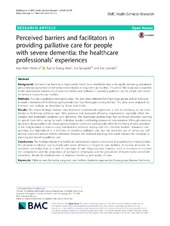| dc.contributor.author | Midtbust, May Helen | en_US |
| dc.contributor.author | Alnes, Rigmor Einang | en_US |
| dc.contributor.author | Gjengedal, Eva | en_US |
| dc.contributor.author | Lykkeslet, Else | en_US |
| dc.date.accessioned | 2019-02-28T17:20:15Z | |
| dc.date.available | 2019-02-28T17:20:15Z | |
| dc.date.issued | 2018-09-12 | |
| dc.Published | Midtbust MH, Alnes REA, Gjengedal E, Lykkeslet E. Perceived barriers and facilitators in providing palliative care for people with severe dementia : the healthcare professionals' experiences. BMC Health Services Research. 2018:18:709 | eng |
| dc.identifier.issn | 1472-6963 | |
| dc.identifier.uri | https://hdl.handle.net/1956/19167 | |
| dc.description.abstract | Background: Dementia has become a major public health issue worldwide due to its rapidly increasing prevalence and an increasing number of dementia-related deaths in long-term care facilities. The aim of this study was to examine health professionals’ experiences of potential barriers and facilitators in providing palliative care for people with severe dementia in long-term care facilities. Methods: This was a qualitative descriptive study. The data were collected from four focus groups and 20 individual in-depth interviews with healthcare professionals from four Norwegian nursing homes. The data were analysed by thematic text analysis, as described by Braun and Clarke. Results: The major findings indicate that healthcare professionals experience a lack of continuity as the main barrier to facilitating palliative care. Time pressure and increased efficiency requirements especially affect the weakest and bedridden residents with dementia. The healthcare professionals feel conflicted between wanting to spend more time caring for each individual resident and feeling pressure to help everyone. Although resources are scarce, dying residents are always given priority by healthcare professionals, either by the hiring of extra personnel or the reorganization of tasks in a way that facilitates someone staying with the terminal resident. Advanced care planning was highlighted as a facilitator in providing palliative care, but the extensive use of temporary staff among nurses and doctors and the relocation between the sheltered and long-term wards threaten the continuity in planning and providing palliative care. Conclusions: The findings indicate that healthcare professionals experienced several structural barriers that prevented the provision of palliative care to people with severe dementia in long-term care facilities. Increasing demands for economic rationality lead to a lack of continuity of care. Organizational changes, such as measures to increase the competence and the proportion of permanent employees and the prevention of burdensome end-of-life transitions, should be implemented to improve continuity and quality of care. | en_US |
| dc.language.iso | eng | eng |
| dc.publisher | BMC | eng |
| dc.rights | Attribution CC BY | eng |
| dc.rights.uri | http://creativecommons.org/licenses/by/4.0/ | eng |
| dc.subject | Palliative care | eng |
| dc.subject | Dementia | eng |
| dc.subject | Long-term care facilities | eng |
| dc.subject | Qualitative approaches | eng |
| dc.subject | Focus groups | eng |
| dc.subject | Barriers | eng |
| dc.subject | Facilitators | eng |
| dc.title | Perceived barriers and facilitators in providing palliative care for people with severe dementia : the healthcare professionals' experiences | en_US |
| dc.type | Peer reviewed | |
| dc.type | Journal article | |
| dc.date.updated | 2018-09-17T11:00:33Z | |
| dc.description.version | publishedVersion | en_US |
| dc.rights.holder | Copyright 2018 The Authors | |
| dc.identifier.doi | https://doi.org/10.1186/s12913-018-3515-x | |
| dc.identifier.cristin | 1610127 | |
| dc.source.journal | BMC Health Services Research | |

